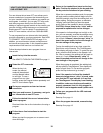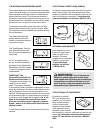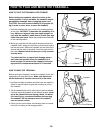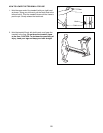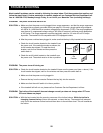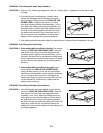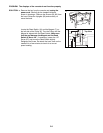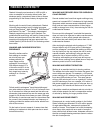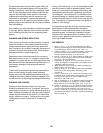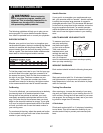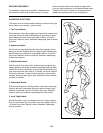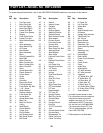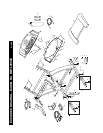26
Several studies have reported that regular walking at
moderate to brisk speeds appears to increase bone
density. Specifically, Fradin and his colleagues
6
found
that 70-year-old subjects who walked at least 30 min-
utes per day had higher bone mineral content than
subjects who walked less than 30 minutes per day.
Jones and his colleagues
7
reported that sedentary
women (aged 30 to 61 years old) who began a regular
walking program and continued for one year increased
their bone density.
Since walking can be comfortably performed by people
of any age, walking appears to be practical and effec-
tive in reducing a person's risk for developing osteo-
porosis.
WALKING AND STRESS REDUCTION
There are many stressors in today's society, including
economic concerns, work-related pressures and the
need to balance career goals with home responsibili-
ties. People who are unable to cope with these types of
stressors are often tense and anxious, and may even
become physically or psychologically ill.
Researchers have found that exercise is one way to
help people reduce stress. For example, subjects who
engaged in a regular aerobic conditioning program and
who altered their diets experienced significant gains in
self-concept, feelings of well-being and reduced
depression.
8
Cramer and his colleagues
9
specifically examined the
effect of brisk walking on mildly obese sedentary
women and found that walking improved general psy-
chological well-being. Walking therefore appears to be
an effective tool for improving psychological well-being.
WALKING AND INJURIES
Walking is often associated with a low injury rate.
Walking is considered to be a "low impact" activity be-
cause one foot remains in contact with the ground at all
times. Walking at speeds of 3 miles per hour produces
vertical impact forces that are around 1.25 times body
weight, whereas running at 7 miles per hour increases
vertical impact forces to more than 2.5 times body
weight.
During a 24-week study, not one of 59 participants who
walked five days a week at speeds between 3 and 5
miles per hour sustained a walking-related injury that
necessitated consulting with a physician. Carroll and
his colleagues
10
reported that 14% of the elderly sub-
jects participating in a walking study suffered training-
related orthopedic injuries, mostly to the lower leg and
foot. The majority of injuries occurred in the group as-
signed to "fast walking."
It is important to note that all forms of exercise have
some degree of risk associated with the activity.
Generally, the less mechanical stress on the muscu-
loskeletal system, the less risk of becoming injured.
Because of the low-impact nature of walking, the inci-
dence of injury appears to be low when compared to
other high-impact activities.
REFERENCES
1. Rippe, J., Ross, J., et. al. ÒCardiovascular effects of walking.Ó
(Abstract), Proceedings of the Second International Conference
on Physical Activity, Aging and Sports, July, 1985, p. 47.
2. Pollock, M., Miller, H. Jr., et. al. ÒEffects of walking on body com-
position and cardiovascular function of middle-aged men.Ó
Journal of Applied Physiology, 1971, 30:126Ð130.
3. Duncan, J., Gordon, N., et. al. ÒWomen walking for health and fit-
ness. How much is enough?Ó Journal of the American Medical
Association, 1991, 266(23):3295Ð9.
4. Paffenbarger, R., Hyde, R., et.al. ÒPhysical activity, all-cause
mortality and longevity of college alumni.Ó New England Journal
of Medicine, 1986, 314:605Ð613.
5. ÒBetter walking workouts.Ó University of California at Berkeley
Wellness Letter, 1992, 8(12):4Ð5.
6. Fradin, K. Grimby, G., et. al. ÒWalking habits and health-related
factors in a 70-year-old population,Ó Gerontology, 1991,
37(5):281Ð8.
7. Jones, P., Hardman, A., et. al. ÒInfluence of brisk walking on the
broadband ultrasonic attenuation of the calcaneus in previously
sedentary women aged 30Ð61 years.Ó Calcified Tissue
International, 1991, 49(2):112Ð5.
8. Blair, S., Collingwood, T., et. al. ÒHealth Promotion for Educators:
Impact on Health Behaviors, Satisfaction, and General Well-
Being,Ó American Journal of Public Health, 1984, 74:147Ð49.
9. Cramer, S., Nieman D., et. al. ÒThe effects of moderate exercise
training on psychological well-being and mood state in women.Ó
Journal of Psychosomatic Research, 1991, 35(4Ð5):437Ð49.
10. Carroll, J., Pollack, M., et. al. ÒIncidence of injury during moderate
and high intensity walking in the elderly.Ó Journal of Gerontology,
1992, 47(3):M61Ð6.



